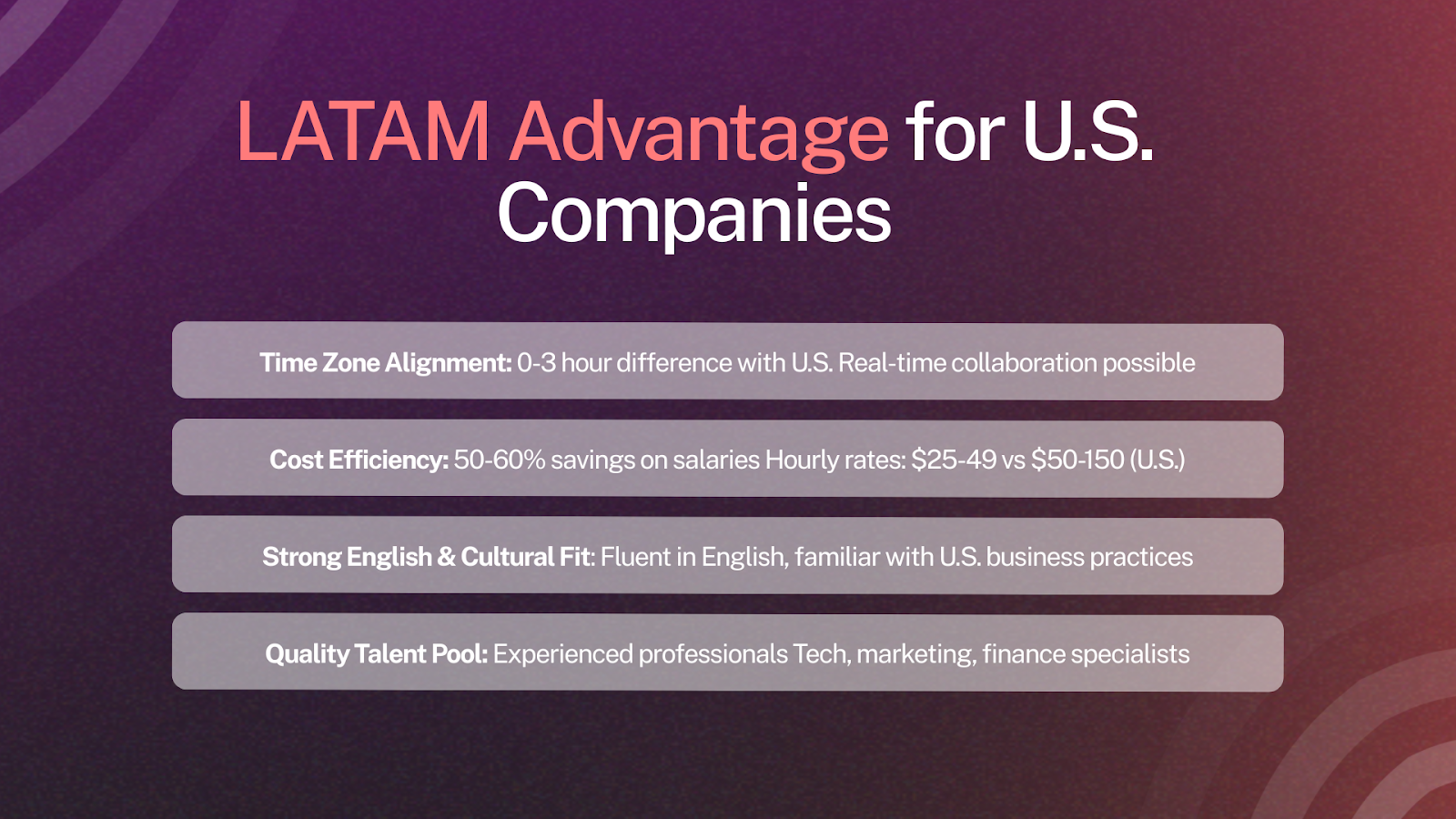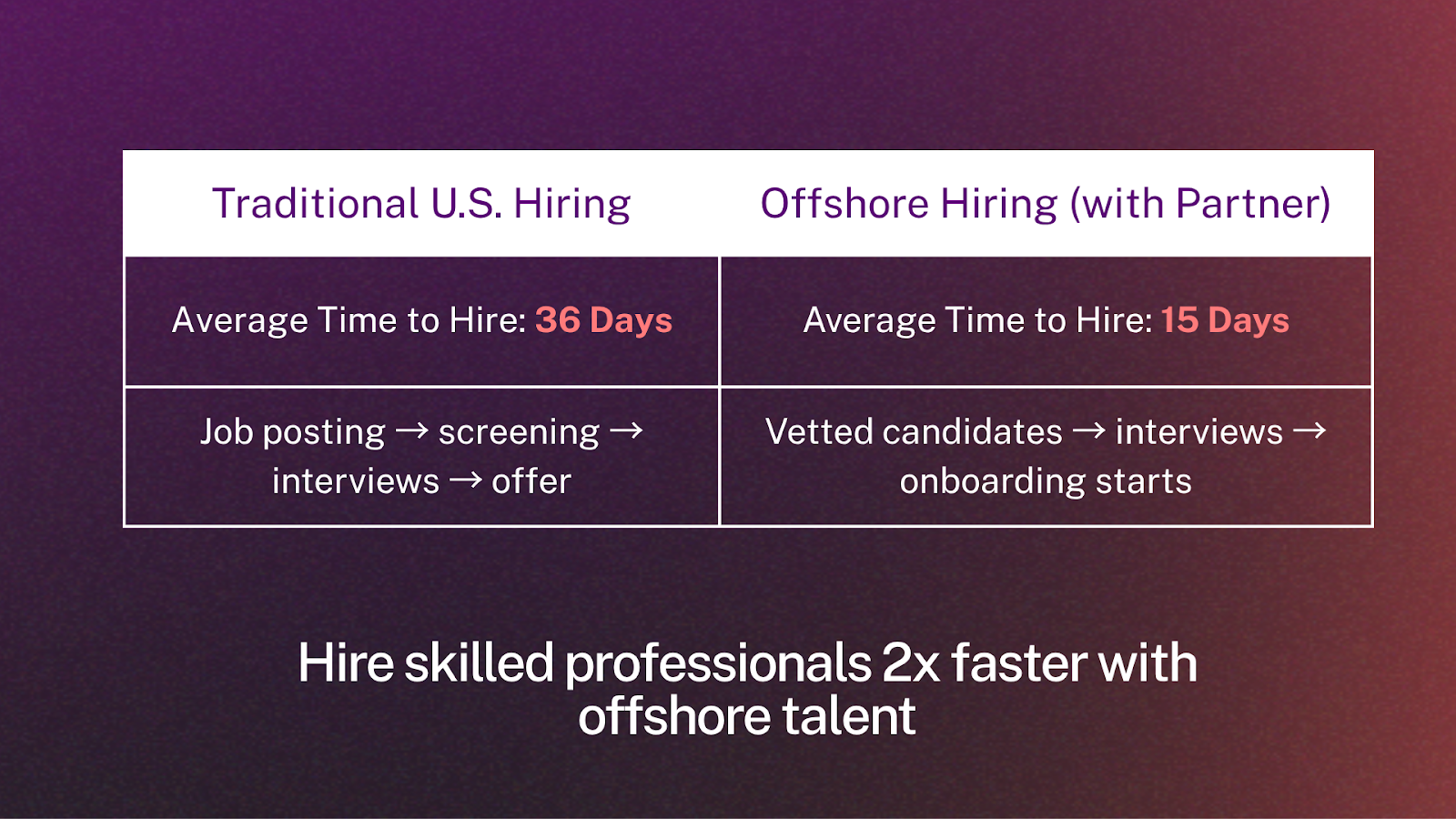Building a team shouldn’t drain your budget or take months to complete. Many companies are hiring offshore to find skilled professionals who deliver quality work at fair costs.
For U.S. businesses, Latin America (LATAM) has become a top region to source offshore talent. Shared time zones, strong communication, and solid expertise make collaboration easier.
Offshore hiring isn’t only about saving money. It’s about faster access to talent, flexibility, and new perspectives.
This guide explains what offshore talent acquisition means in 2025 and how to build a team that scales with your business.
What Is Offshore Talent Acquisition?
Offshore talent acquisition is the process of recruiting and managing professionals outside a company's home country, often in regions like LATAM, to reduce costs, scale operations, and access top global talent.
This isn’t now about outsourcing short-term tasks. It’s building real teams that work alongside your existing staff and contribute to long-term goals.
LATAM has become a top choice for U.S. businesses because of shared time zones, strong English proficiency, and cultural fit. A developer in Colombia can join your 10 a.m. standup without adjusting their entire schedule.
How Offshore Recruitment Differs from Local Hiring
Local hiring follows a familiar path: post jobs, screen resumes, interview candidates within driving distance, and onboard them into your office or nearby. Offshore recruitment requires a different infrastructure.
You need to understand international labor laws, set up compliant payment systems, and build remote collaboration practices.
But the core difference is access. Your local talent pool might have 50 qualified candidates. Going offshore expands that to thousands. You're no longer competing with every tech company in San Francisco for the same senior designer or marketing manager.
Industries Leading Offshore Hiring
Technology and IT make up the largest share of offshore hiring, followed by marketing, finance, and customer support. More companies are now building offshore teams that work directly with in-house staff instead of using short-term outsourcing.
Why Offshore Hiring Is Growing
Access a Wider Global Talent Pool
Talent shortages make it hard to find specialized roles locally, whether it’s a machine learning engineer or a growth marketer. Hiring offshore expands your candidate pool significantly.
Latin America (LATAM) has a large and rapidly growing tech talent pool, with many professionals experienced in working with U.S. companies and familiar with common tools and business practices.

Reduce Hiring Costs Without Compromising Quality
The cost differences between U.S. and LATAM salaries are significant for experienced roles:
Role
Sources: Glassdoor 2025, Payscale 2025
Hourly rates:
These figures show that offshore talent acquisition in LATAM offers a perfect balance between cost savings and collaboration efficiency.
Accelerate Hiring and Scaling

U.S. hiring typically takes around 36 days (LinkedIn 2024). Offshore recruitment through experienced partners can shorten this. Candidates can be interviewed within days and start in about two weeks.
Scaling is easier, too. Adding a few customer support agents locally can take months. Offshore, a trained team can be ready in roughly half that time.
Increase Resilience and Flexibility
Having teams in different regions reduces the impact of local disruptions. LATAM’s 0-3 hour time difference with the U.S. allows work to continue across offices without major schedule conflicts.
Teams in Bogotá, for example, finish their day just after U.S. teams start, helping maintain workflow.
Challenges in Offshore Talent Acquisition
Offshore hiring involves typical operational challenges, but they can be managed with the right processes and support.
- Time zones are important; set core overlap hours and use async tools.
- Employment laws and taxes vary; consider an Employer of Record (EOR).
- English is generally strong; encourage inclusion and treat offshore staff as full team members.
- Retention depends on fair pay, career paths, and recognition.
How Offshore Talent Acquisition Works?
Step 1: Define Your Hiring Needs
Clarify the roles you need and the skills required. Identify which experience levels fit your team and outline how offshore staff will integrate.
Set your goals for the first 30, 60, and 90 days. Include budget and benefits considerations, as these affect retention and performance.
Step 2: Source and Screen Candidates
Sourcing offshore means using different channels than local hiring. Job boards work, but regional platforms often produce better results.
Screen early for language, technical skills, and cultural fit. Phone screens and short assessments help filter candidates before full interviews.
Step 3: Interview, Select, and Onboard
Video interviews are standard and should involve the team they’ll work with. Reference checks are critical, since in-person verification may not be possible.
Onboarding should include tools, access, and a structured first week. Assign a contact to guide them and ensure they integrate smoothly.
Step 4: Integrate and Train
Integration starts after onboarding. Include offshore staff in company meetings and updates, provide the same training as local employees, and support their growth with courses, certifications, or mentorship. This builds consistent capability across the team.
Step 5: Manage and Track Performance
Focus on results rather than hours logged. Conduct regular one-on-ones to address blockers and provide feedback. Offshore employees need consistent support, just like any other team member.
Partners like Floowi can simplify this process, handling sourcing, compliance, and onboarding so teams can start contributing in as little as 15 days.
Best Practices for Successful Offshore Hiring
Implement structured practices to ensure offshore hires integrate smoothly and perform effectively.
1. Build a Clear Employer Brand
Top offshore talent evaluates companies carefully. Highlight remote-friendly policies, professional development opportunities, and examples of offshore employees who have grown internally. Show that offshore team members are treated equally.
2. Use Automation and Recruitment Platforms
Applicant tracking systems, skill assessments, and scheduling tools streamline hiring and standardize evaluation.
Keep some personal interaction - a quick video message after initial screening shows candidates they’re valued.
3. Encourage Collaboration and Inclusion
Set overlap hours for real-time discussion and problem-solving. Use asynchronous tools for updates and documentation. Recognize offshore contributions publicly to ensure visibility and engagement.
4. Partner with a Reliable Recruitment Agency
Each approach works for different situations. Partner agencies work well when you need to scale quickly without internal offshore HR expertise.
5. Track Important Metrics
Focus on time-to-hire, retention, and quality of hire. With good partners, offshore hires typically start in 15-30 days.
Retention shows if you’re managing well - 6- and 12-month rates above 80% are solid.
Assess quality through performance reviews, manager feedback, and measurable output; offshore employees should meet or exceed the level of local hires.
Benefits of Offshore Talent Acquisition
- Lower Costs: Offshore roles can be 50-60% cheaper than local equivalents.
- Access Skills: Find specialized roles and language-proficient professionals not easily available locally.
- Extended Hours: Teams in different time zones keep work moving after U.S. office hours.
- Diverse Perspectives: Remote teams bring varied experiences for better problem-solving.
- Stronger Reputation: Global teams show structured remote work and inclusivity, attracting talent.
How to Choose the Right Offshore Talent Partner?
Experience and Industry Focus
Choose a partner with experience in your sector. A firm that places top talent understands the roles better. They know what to screen for and where to find specialists.
Ask about their track record. How many placements have they made in roles like yours? What's their average time-to-hire? How long do their placements typically stay?
Compliance and Data Security
Ensure the partner handles local employment laws correctly and protects sensitive information.
Check contracts for confidentiality and IP agreements, and confirm where and how data is stored.
Review Case Studies, Testimonials, and Success Metrics
Look for examples relevant to your size and needs. Talk to references about candidate quality, responsiveness, and how challenges were handled.
Tools, Scalability, and Long-Term Fit
Good partners use modern recruitment tools and can integrate with your systems. They should scale with you, whether you're hiring 2 people or 20.
Think long-term. Switching recruitment partners is disruptive. Find someone you can work with for years as your needs evolve.
Questions to Ask Before Choosing an Offshore Talent Partner
- What's your average time from kickoff to candidate interviews?
- How do you screen for technical skills and cultural fit?
- What happens if a placement doesn't work out in the first 90 days?
- How do you handle payroll, benefits, and local compliance?
- What ongoing support do you provide after placement?
- Can you share references from companies similar to ours?
Future Trends in Offshore Talent Acquisition
AI is starting to handle the early stages of hiring - screening resumes, scoring skills, even running first-round interviews.
It saves time, but you still need to check that candidates actually have the skills they claim.
Soft skills are becoming just as important as technical ones. In remote teams, communication, problem-solving, and the ability to learn quickly often make the difference.
Remote-first is no longer just for “offshore” teams. Companies are building processes for distributed work, and pay models are shifting to reward results rather than location.
Getting Started
Building global teams means hiring efficiently while keeping vetting and compliance in place. Talent is distributed worldwide, and accessing it gives your company an edge.
Start your offshore talent acquisition journey with Floowi - connect with vetted LATAM professionals ready to join your team in under 15 days.



.png)






.png)
.png)
%20U.S.%20vs%20LATAM%20Pay%20Guide.png)
